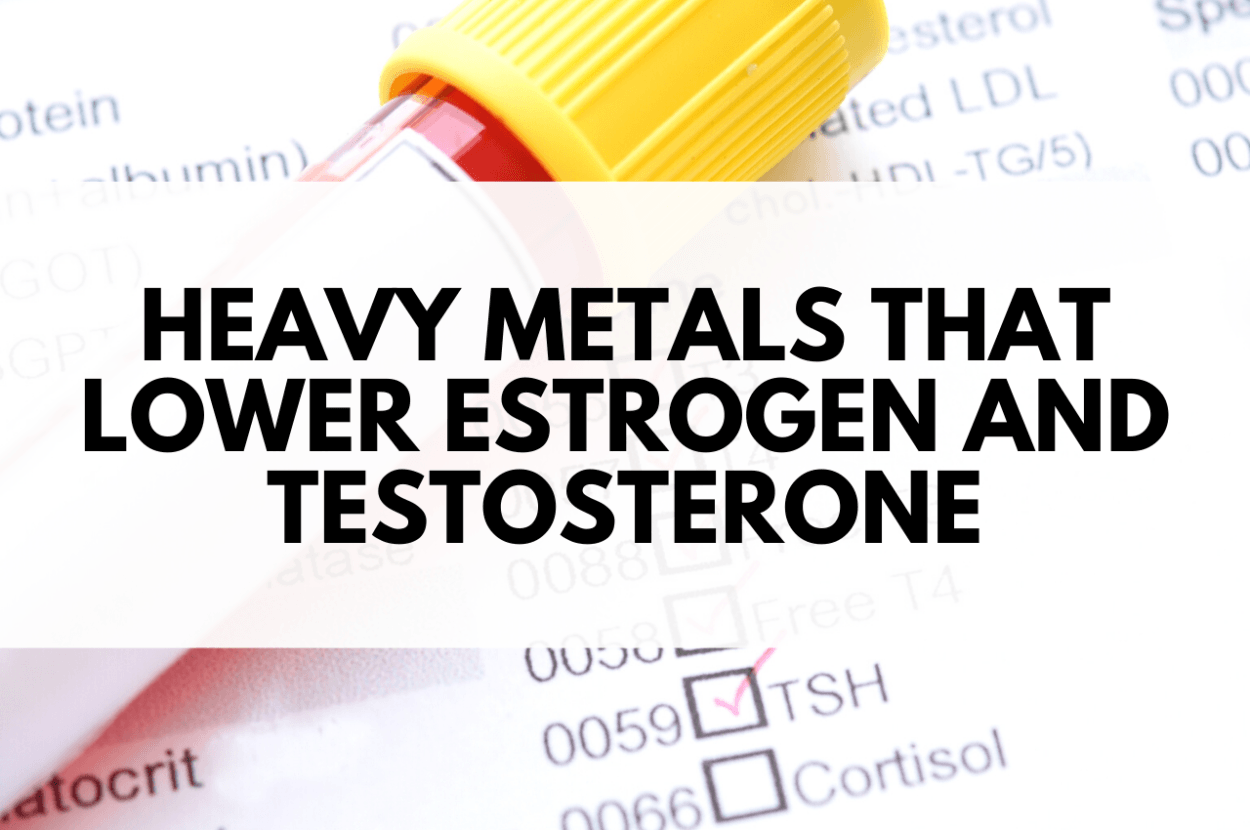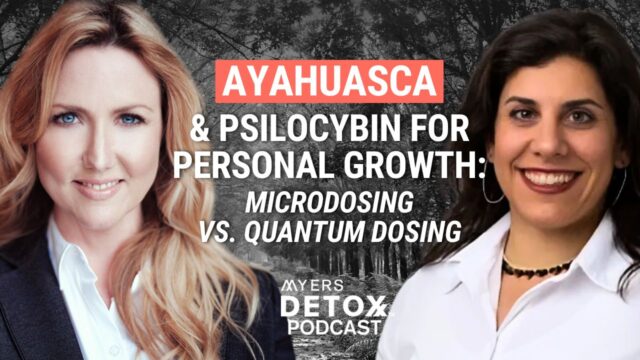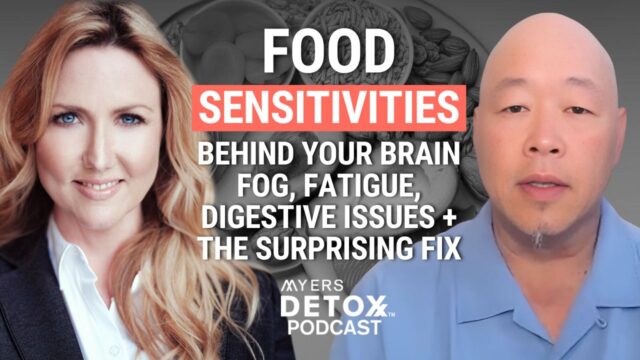Discover how heavy metals lower estrogen and testosterone levels – as well as how to rebalance your hormones!
What you will learn in this article:
- Heavy metal toxicity is a very common (and overlooked) cause of hormone imbalance.
- Different heavy metals cause different symptoms, ranging from fatigue and brain fog to gut issues and headaches.
- This article will cover the four most common heavy metals that cause hormone imbalance: mercury, cadmium, lead, and arsenic (but there are many more).
- Read on to learn about the symptoms, causes, and ways to fix heavy metal toxicity and rebalance your hormones.
If you’re a woman, do you suffer from PMS, irregular periods, infertility, or horrible perimenopause and menopause symptoms such as hot flashes, night sweats, and weight loss resistance?
If you’re a man, have you experienced a decline in libido, erectile dysfunction, loss of muscle tone, and noticed that you are grumpier and more short-tempered than you used to be?
These are all symptoms of a hormone imbalance, which doctors say affects an increasing number of people these days, causing fatigue, brain fog, depression, anxiety, and sleep problems in both women and men.
A variety of factors can imbalance the hormones, including blood sugar that is too high or low, chronic stress, low thyroid function, and birth control pills.
However, one factor that is commonly overlooked is the effect of heavy metals on the endocrine (hormonal) system. We are exposed to unprecedented levels of heavy metals from industrial pollution these days, and the human endocrine system — particularly women’s — is extremely sensitive to and easily thrown off balance by these toxins.
We are exposed to heavy metals each day in our air, water, food, and the products we use, particularly commercial cosmetics and body products. This ongoing exposure leads to a buildup of heavy metals in our bodies.
Heavy metal toxicity produces different symptoms in different people depending on their genetic predisposition and the types of metals accumulating in their bodies. This makes it difficult for a health care practitioner to connect specific symptoms with heavy metals.
In fact, most doctors, whether conventional or alternative, do not even consider heavy metal toxicity when it comes to hormonal imbalances.
But you should know that it’s impossible to escape heavy metal toxicity these days and they could absolutely be quietly poisoning your organs and disrupting your hormone balance.
Although it sounds hopeless, the good news is that it’s easy and affordable to test for heavy metals from home and that there are safe, simple things you can do every day to help remove them from your body on an ongoing basis.
In this article, I show you the ways in which heavy metals disrupt hormone function, the four most common heavy metals that cause hormone imbalances, and how you can integrate daily heavy metal detoxing into your everyday routine.
Why You Should Care About Hormone Imbalance
Hormones play many vital roles in our body. Without them, we would cease to function. Hormones are signaling molecules that tell various organs and systems in the body how to behave. Think of them as the traffic lights on busy city roads that keep things flowing while preventing chaos, collisions, and traffic jams. They determine the speed of your metabolism, whether you have inflammation, how well you sleep, whether your brain functions, and much more.
Hormones communicate with and influence one another and are building blocks for other hormones. This can promote optimal health in a best-case scenario or cause hormone imbalance symptoms when things aren’t working right.
For instance, men with a hormone imbalance can produce too much estrogen, developing breasts and suddenly crying at commercials, and other female characteristics. Meanwhile, women can produce too much testosterone, causing balding, thicker facial hair, and other male characteristics.
Another example: Too much stress can cause precursors for progesterone to go towards the production of extra stress hormones instead. The resulting progesterone deficiency causes PMS and poor fertility. Then the high stress hormones promote weight gain and raise the risk of pre-diabetes and diabetes.
In other words, no hormone acts independently. An imbalance in just one hormone can trigger a cascade of imbalances in all the others. For instance, low thyroid hormone activity can skew function in all the other hormones.
Although it’s important to pay attention to important factors such as your diet, stress levels, and physical activity, you must not overlook the impact of heavy metals on our finely orchestrated endocrine systems.
But first, let’s explore how heavy metal toxicity happens in the first place.
How Our Bodies Accumulate and Store Heavy Metals
Sadly, pollution has become so ubiquitous that there is no escaping heavy metals these days. They are in our air, water, soil, foods, and everyday products, especially in common cosmetics and body products. As the environment continues to become more polluted, levels of heavy metals in our environment will continue to rise.
Although our bodies have built-in detoxification organs and systems, they were not designed for the constant onslaught of heavy metals we encounter today. We also battle other aspects of modern life that hinder our ability to efficiently detoxify, such as chronic stress, poor diets, and sleep deprivation.
Here are five reasons heavy metals accumulate in our bodies:
- Our diet may not include enough of the nutrients necessary for detoxification.
- Mineral deficiency — sufficient minerals are necessary to push metals out of the body and prevent heavy metals from lodging in tissue
- Stress and inflammation impair detoxification pathways.
- Sleep deprivation inhibits removal of toxins.
- Fatigue from poor cellular energy robs the body of sufficient energy to detox.
All of these factors impede the body’s detoxification pathways, thus promoting the accumulation of heavy metals in body tissue. While the liver and kidneys can break down small amounts of heavy metals, (Study), eventually this buildup starts to cause symptoms — the symptoms someone develops can depend on that person’s genetic predispositions. if you have been suffering with any of these conditions for years or even decades, you probably have an advanced degree of heavy metals built up in your body.
The scary thing is that heavy metals affect our brains. This is because in order to protect the vital organs, the body stores toxins like heavy metals in fat tissue. Well, the brain is made up of about 60 percent fat and very vulnerable to heavy metal toxicity. [Study][Study]
How Heavy Metals can Lead to a Hormone Imbalance
Over the years, this accumulation of heavy metals in body tissue begins causing subtle and gradual damage and ever worsening symptoms.
Because they are so intrinsic to our ongoing function, hormones and hormone glands inevitably take a hit from heavy metal buildup.
Heavy metals can cause a hormone imbalance in several ways, including:
- They accumulate in hormone-producing glands. [Study]
- They increase estrogen levels. [Study]
- They disrupt the finely tuned hormone production feedback loop between the hormone glands and the brain.
- They get in the way of hormone receptor sites on cells, blocking the action of hormones.
- They poison enzymes that create hormones and convert them to other forms.
- They trigger cellular damage and contribute to elevated levels of stress hormones and inflammation. [Study]
When it comes to toxicity, estrogen, the primary female hormone, is especially impacted. Many toxic chemicals in our environment today are “estrogen mimickers” or “environmental estrogens,” meaning they are similar enough to estrogen to confuse the body and contributes to a hormone imbalance.
For instance, a number of heavy metals identified as environmental estrogens bind to estrogen receptor sites on cells, trigger estrogen-activated genetic pathways, interact with amino acids, and deactivate enzymes that convert sex hormones into other necessary hormones. [Study] [Study] [Study] [Study]
In other words, these heavy metals are just similar enough to estrogens to interfere in hormone pathways. But because they are heavy metals such as lead, cadmium, and mercury and not actually estrogen, they cause dysfunctions in hormone pathways. This negatively impacts hormone production, conversion, and function. The end result is a hormone imbalance and a wide range of symptoms.
The Top Four Heavy Metals That Cause Hormone Imbalance
You must deal with heavy metal toxicity to help restore hormone balance. Below are the four heavy metals most commonly associated with hormone imbalance and symptoms such as infertility, fatigue, brain fog, moodiness, and weight gain.
1. Mercury
Statistically, we all have mercury in our bodies thanks to exposures from amalgam fillings, coal burning, industrial manufacturing, fish, shellfish, and even some medications. [Study]
Mercury causes a hormone imbalance by lowering progesterone and raising estrogen. It is also linked to thyroid hormone disruption, which often causes weight gain and chronic fatigue [Study].
There are two different kinds of mercury: methylmercury and inorganic mercury. Methylmercury is more common and comes from eating seafood that’s high on the food chain as well as crustaceans on the ocean floor. That’s because it accumulates in the tissue of shellfish and larger migratory fish that eat smaller fish. The EPA suggests moderating your intake of fish like tuna, swordfish, shark, mackerel, and marlin. It’s estimated that in general we take in about 10 mcg of mercury daily from food. [Study]
Inorganic mercury is found in silver mercury amalgam dental fillings. Women who have 4–10 amalgam fillings are estimated to uptake 8–30 mcg of mercury daily. For women with 10 or more fillings, that number rises to 163 mcg each day (4,6).
So, is that a lot of mercury or a little bit?
According to the World Health Organization, the upper limit for safety is only 2 mcg per kilogram of body weight per day, or 2 mcg per 2.2 pounds. [Study] For a woman weighing 140 pounds, her mercury intake should not exceed 127 mcgs a day. A woman with 10 or more fillings is far surpassing that amount at 163 mcg, and this not include mercury exposure from other sources.
Although many people have their mercury fillings replaced, unfortunately the mercury you accumulated from having them for so long is likely still accumulated in your body tissue.
2. Cadmium
Cadmium is another heavy metal that is abundant in our environment and that disrupts hormone balance. [Study][Study] We are exposed to cadmium from cigarette smoke, water, fertilizers, air pollution, fish, coffee, plastics, and some yellow coloring agents [Study].
Cadmium is linked to low levels of progesterone and prolactin (the hormone that triggers the production of breast milk) as well as lowered testosterone and infertility in males [Study] [Study] [Study]
The unfortunate thing about cadmium is it accumulates in the pituitary gland, our master hormone gland. The pituitary gland is in the brain and acts as an air traffic controller for all the body’s hormones, directing hormone production based on feedback loops between the brain and the hormone glands. These include the thyroid, adrenals, ovaries, and testes; cadmium can impact function in these areas. [Study]
Cadmium also blocks and mimics estrogen, which has been linked to fertility issues in both women and men. [Study] Because it blocks estrogen receptors, you can suffer from an estrogen imbalance even if your body makes enough. This is because it’s not getting into your cells and your body perceives this as a deficiency. [Study]
Cadmium is also a carcinogen. It causes more cancers than all the other heavy metals combined, included prostate cancer and breast cancer [Study].
Cigarette smoke is the most common and concentrated source of cadmium. Tobacco plants absorb high amounts of cadmium from the soil, which is then released into the bloodstream when smoked. This is the primary reason smokers have significantly higher rates of cancer.
Cadmium also accumulates in the kidneys, thus contributing to not only kidney disease but also poor bone health. The accumulation of cadmium in the kidneys causes them to excrete higher levels of calcium in the urine, thus decreasing calcium levels in bones (estrogen deficiency also lowers bone density). Lowered bone density leads to bone pain, bones that fracture easily, kidney stones, osteomalacia (softer bones), and osteoporosis (brittle bones). [Study]
3. Lead
Lead interferes with the production of sex hormones, and is linked to irregular menstrual cycles and infertility by inhibiting progesterone, prolactin, and estrogen activity. [Study], [Study] It also reduces testicular function in men and levels of the stress hormone cortisol, which can cause fatigue.
Thankfully, lead levels have decreased since the 1950s with the introduction of unleaded gasoline and lead-free paints. Nevertheless, lead paint continues to be the most common cause of lead exposure in many older homes.
Because lead is water-soluble, it easily leaches into tap water. If you have paid attention to the news, you know this has been a major issue these days. Lead piping can contaminate and entire region’s water supply in older systems.
In Flint, MI, lead contamination of the city’s water supply reached a crisis point in 2014 and still has not been remedied more than five years later. [Study].
Washington, DC, had dangerously elevated lead levels from 2002–2010, according to tests from the Center for Disease Control (CDC)[Study]
Although lead is now regulated, decades of leaded gasoline and it’s continued use in developing countries have caused lead to persist in the air, soils, and water, contaminating our food supply and many supplements.
Regular testing of foods by the FDA has shown that 20 percent of more than 2,000 baby food samples and 14 percent of more than 10,000 food samples had detectable levels of lead. [Study] [Study] Lead gets into our food supply through air, water, and soil because of pollution.
4. Arsenic
Arsenic is common in treated lumber made before 2002, in pesticides, and in air pollution from fossil fuel combustion. Because rice so readily absorbs arsenic from water and soil, some brands of rice contains arsenic. You should always rinse uncooked rice until the rinse water is no longer cloudy.
Arsenic damages insulin-producing cells in the pancreas. Because insulin regulates blood sugar, this can promote weight gain and fatigue. The accumulation of arsenic in tissues over time can even damage insulin production enough to cause diabetes[*]. Arsenic also damages the testes, thus decreasing sex hormone production in men.
Arsenic contributes to weight gain and weight loss resistance by poisoning the enzymes that transport fat out of fat cells.
How to Safely and Effectively Detox Heavy Metals
Do you wonder if you have accumulated heavy metals in your tissues? The way to find out is with a heavy metals test.
The most convenient and affordable way to test for heavy metals is through hair mineral analysis (HTMA). HTMA gives you a full report of heavy metals in your body after analyzing both the heavy metal and mineral content in your hair. You can order an HTMA test here.
Since we all have heavy metals in our body, why do some people suffer more than others? Reasons include methylation status (an important process in detoxification), nutritional status, and lifestyle. I find the sicker someone is, the higher their toxic burden. But because they are so sick, they are unable to effectively detox heavy metals and thus suffer severe symptoms. This can be evidenced by a negative HTMA test, which means the body is not excreting heavy metals.
If this sounds like you, don’t worry. There are plenty of strategies you can employ.
- Infrared saunas use infrared light to directly heat your body, helping release stored heavy metals and toxins from cells through sweat. Learn more about infrared saunas here.
- Coffee enemas transport polyphenols and other antioxidants to the liver, facilitating its ability to detoxify. Learn more about coffee enemas here.
- Detox supplements bind to heavy metals and support your liver and kidneys to flush them out. Read this article on why you should use binders.
It’s best to start a heavy metal detox with a HTMA for two reasons.
One, it will tell you what metals you have as different heavy metals require different detox supplements.
Two, follow-up testing allows you to track your progress and adjust your protocol as needed.
Are you still struggling with a hormone imbalance, brain fog, fatigue, weight loss resistance, depression, and more despite having tried the best diets, supplements, exercises, and everything else under the sun? If so, then it’s time to get to the root cause.
I strongly encourage you to explore heavy metals as a frequently overlooked yet common underlying cause of so many health issues.
If you think you may be struggling with heavy metals, take the first step in restoring your vitality and get tested with an HTMA.
*Please note that A Hair Mineral Analysis (HTMA) is not intended to diagnose, treat, cure, reverse, or prevent any disease. It is not intended to replace any other medical test(s) that may be prescribed by your medical doctor.









